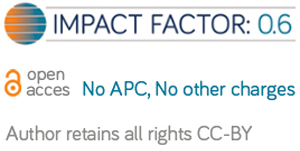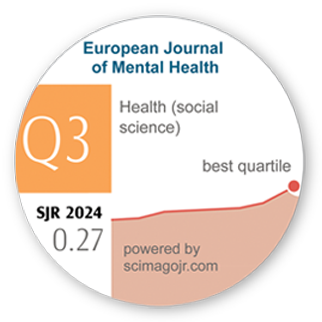Contrasting the Treatment-Related Perceptions of Parents and Their Children: Using Data from Child and Adolescent Brief Mental Health Services Recipients in Canada
DOI:
https://doi.org/10.5708/EJMH.19.2024.0020Keywords:
child and adolescent mental health services, parent-child agreement, informant discrepancy, brief therapy, mixed methodsAbstract
Introduction: Discrepancies between parental and child perceptions of problems and their therapeutic expectations can negatively impact mental health treatment efficacy.
Aims: We sought to explore concordance and discrepancy in families receiving brief, client-centered, and strengths-based mental health services, specifically by contrasting parents’ and children’s perceptions of the child’s presenting issues; treatment expectations; and levels of concern pre- and post-treatment. We also examined the psychometric properties of a therapeutic scaling question on the level of concern, by examining associations with scores from the Strengths and Difficulties Questionnaire.
Methods: Using a mixed-methods approach, we examined data from openand closed-ended questions, some used as part of the treatment. This included brief descriptions of perceived presenting issues and treatment expectations, and levels of concern on a scale of 1 to 10.
Results: Parent and child descriptions of issues were judged generally congruent 66% of the time. Respectively, minor and major non-congruence was observed 25% and 9% of the time. In terms of treatment expectations, parents were more likely to express a desire to understand the issues and improve communication in the family. Children were more likely to express no expectancies or respond with simple statements (e.g., feel better). Parents initially rated their children’s problems as more severe than did their children. We found that the scaling question demonstrated a modest association with the level of concern from the Strength and Difficulties Questionnaire (SDQ).
Conclusions: Even though most parents and their children broadly agree on presenting mental health issues for which they seek counseling, important differences manifest in how they perceive them and what they want accomplished during sessions. Practitioners need to consider, assess, and accommodate such discrepancies.
References
Abdel-Khalek, A. M. (2006). Measuring happiness with a single-item scale. Social Behavior and Personality: An International Journal, 34(2), 139–150.
http://doi.org/10.2224/sbp.2006.34.2.139
Achenbach, T. M., McConaughy, S. H., & Howell, C. T. (1987). Child/adolescent behavioral and emotional problems: Implications of cross-informant correlations for situational specificity. Psychological Bulletin, 101(2), 213–232.
http://doi.org/10.1037/0033-2909.101.2.213
Angold, A., Messer, S. C., Stangl, D., Farmer, E. M., Costello, E. J., & Burns, B. J. (1998). Perceived parental burden and service use for child and adolescent psychiatric disorders. American Journal of Public Health, 88, 75–80.
http://doi.org/10.2105/ajph.88.1.75
Azzi-Lessing, L. (2013). Serving highly vulnerable families in home-visitation programs. Infant Mental Health Journal, 34(5), 376–390.
http://doi.org/10.1002/imhj.21399
Bajeux, E., Klemanski, D. H., Husky, M., Leray, E., Chee, C. C., Shojaei, T., Fermanian, C., & Kovess-Masfety, V. (2018). Factors associated with parent–child discrepancies in reports of mental health disorders in young children. Child Psychiatry & Human Development, 49, 1003–1010.
https://doi.org/10.1007/s10578-018-0815-7
Bannink, F. P. (2007). Solution-focused brief therapy. Journal of Contemporary Psychotherapy, 37, 87–94.
http://doi.org/10.1007/s10879-006-9040-y
Barrett, M. S., Chua, W.-J., Crits-Christoph, P., Gibbons, M. B., & Thompson, D. (2008). Early withdrawal from mental health treatment: Implications for psychotherapy practice. Psychotherapy: Theory, Research, Practice, Training, 45(2), 247–267.
http://doi.org/10.1037/0033-3204.45.2.247
Barwick, M., Urajnik, D., Sumner, L., Cohen, S., Reid, G., Engel, K., & Moore, J. E. (2013). Profiles and service utilization for children accessing a mental health walk-in clinic versus usual care. Journal of Evidence-Based Social Work, 10(4), 338–352.
http://doi.org/10.1080/15433714.2012.663676
Bond, C., Woods, K., Humphrey, N., Symes, W., & Green, L. (2013). Practitioner review: The effectiveness of solution focused brief therapy with children and families: A systematic and critical evaluation of the literature from 1990–2010. Journal of Child Psychology and Psychiatry, 54(7), 707–723.
http://doi.org/10.1111/jcpp.12058
Boneau, C. A. (1960). The effects of violations of assumptions underlying the t test. Psychological Bulletin, 57(1), 49–64.
https://doi.org/10.1037/h0041412
Braun, V., & Clarke, V. (2006). Using thematic analysis in psychology. Qualitative Research in Psychology, 3(2), 77–101.
https://doi.org/10.1191/1478088706qp063oa
Creswell, J. W., & Plano Clark, V. L. (2011). Designing and conducting mixed methods research (2nd ed.). Sage.
De Los Reyes, A. (2011). Introduction to the special section: More than measurement error: Discovering meaning behind informant discrepancies in clinical assessments of children and adolescents. Journal of Clinical Child & Adolescent Psychology, 40(1), 1–9.
https://doi.org/10.1080/15374416.2011.533405
De Los Reyes, A., & Kazdin, A. E. (2005). Informant discrepancies in the assessment of childhood psychopathology: A critical review, theoretical framework, and recommendations for further study. Psychological Bulletin, 131(4), 483–509.
http://doi.org/10.1037/0033-2909.131.4.483
De Los Reyes, A., & Kazdin, A. E. (2006). Informant discrepancies in assessing child dysfunction relate to dysfunction within mother-child interactions. Journal of Child and Family Studies, 15, 643–661.
http://doi.org/10.1007/s10826-006-9031-3
De Los Reyes, A., Talbott, E., Power, T. J., Michel, J. J., Cook, C. R., Racz, S. J., & Fitzpatrick, O. (2022). The Needs-to-Goals Gap: How informant discrepancies in youth mental health assessments impact service delivery. Clinical Psychology Review, 92, Article 102114.
https://doi.org/10.1016/j.cpr.2021.102114
De Los Reyes, A., Wang, M., Lerner, M. D., Makol, B. A., Fitzpatrick, O. M., & Weisz, J. R. (2023). The Operations Triad Model and youth mental health assessments: Catalyzing a paradigm shift in measurement validation. Journal of Clinical Child & Adolescent Psychology. 52(1), 19–54.
https://doi.org/10.1080/15374416.2022.2111684
de Shazer, S., Berg, I. K., Lipchik, E., Nunnally, E., Molnar, A., Gingerich, W., & Weiner-Davis, M. (1986). Brief therapy: Focused solution development. Family Process, 25(2), 207–221.
http://doi.org/10.1111/j.1545-5300.1986.00207.x
Edelbrock, C., Costello, A. J., Dulcan, M. K., Conover, N. C., & Kala, R. (1986). Parent‐child agreement on child psychiatric symptoms assessed via structured interview. Journal of Child Psychology and Psychiatry, 27(2), 181–190.
Ellenbogen, S., Hair, H. J., Kirkland Smith, J., & Wilton, P. (2019). The change clinic counselling service: Blending client-centred and strength-based practices to improve mental health services to families. Canadian Journal of Community Mental Health, 38(1), 1–8.
https://doi.org/10.7870/cjcmh-2018-021
Farmer, E. M. Z., Burns, B. J., Angold, A., & Costello, E. J. (1997). Impact of children’s mental health problems on families: Relationships with service use. Journal of Emotional and Behavioral Disorders, 5(4), 230–238.
http://doi.org/10.1177/106342669700500406
Fischer, R. L. (2004). Assessing client change in individual and family counseling. Research on Social Work Practice, 14(2), 102–111.
http://doi.org/10.1177/1049731503257868
Fitzpatrick, O. M., Holcomb, J. M., Weisz J. R., & Langer, D. A. (2023). Shared decision-making as a tool for navigating multi-stakeholder discrepancies in youth psychotherapy. Journal of Clinical Child & Adolescent Psychology, 52(1), 95–107.
http://doi.org/10.1080/15374416.2022.2127105
Franklin, C. (2015). An update on strengths-based, solution-focused brief therapy. Health & Social Work, 40(2), 73–76.
http://doi.org/10.1093/hsw/hlv022
Friesen, B. J., & Huff, B. (1996). Family perspectives on systems of care. In B. A. Stroul (Ed.), Children's mental health: Creating systems of care in a changing society (pp. 41–68). Paul H. Brookes Publishing Co.
Garland, A. F., Lewczyk-Boxmeyer, C. M., Gabayan, E. N., & Hawley, K. M. (2004). Multiple stakeholder agreement on desired outcomes for adolescents’ mental health services. Psychiatric Services, 55(6), 671–676.
https://doi.org/10.1176/appi.ps.55.6.671
Gingerich, W. J., & Peterson, L. T. (2013). Effectiveness of solution-focused brief therapy: A systematic qualitative review of controlled outcome studies. Research on Social Work Practice, 23(3), 266–283.
http://doi.org/10.1177/1049731512470859
Goldberg, D., & Campbell, F. (1997). Empowerment: A three-session intervention. Child and Adolescent Mental Health, 2(1), 34–37.
http://doi.org/10.1111/j.1475-3588.1997.tb00043.x
Goodman, R. (2001). Psychometric properties of the Strengths and Difficulties Questionnaire (SDQ). Journal of the American Academy of Child and Adolescent Psychiatry, 40(11), 1337–1345.
https://doi.org/10.1097/00004583-200111000-00015
Goodman, R., Meltzer, H., & Bailey, V. (1998). The strengths and difficulties questionnaire: A pilot study on the validity of the self-report version. European Child and Adolescent Psychiatry, 7, 125–130.
https://doi.org/10.1007/s007870050057
Goolsby, J., Rich, B. A., Hinnant, B., Habayeb, S., Berghorst, L., De Los Reyes, A., & Alvord, M. K. (2018). Parent–child informant discrepancy is associated with poorer treatment outcome. Journal of Child and Family Studies, 27, 1228–1241.
https://doi.org/10.1007/s10826-017-0946-7
Government of Newfoundland & Labrador. (2005). Working together for mental health: A provincial policy framework for mental health and addictions services in Newfoundland and Labrador.
https://www.gov.nl.ca/hcs/files/publications-working-together-for-mental-health.pdf
Hair, H. J., Shortall, R., & Oldford, J. (2013). Where’s help when we need it? Developing responsive and effective brief counseling services for children, adolescents, and their families. Social Work in Mental Health, 11(1), 16–33.
https://doi.org/10.1080/15332985.2012.716389
Jacob, J., Edbrooke-Childs, J., Holley, S., Law, D., & Wolpert, M. (2016). Horses for courses? A qualitative exploration of goals formulated in mental health settings by young people, parents, and clinicians. Clinical Child Psychology and Psychiatry, 21(2), 208–223.
https://doi.org/10.1177/1359104515577487
Janoff-Bulman, R. (1989). The benefits of illusions, the threat of disillusionment, and the limitations of inaccuracy. Journal of Social & Clinical Psychology, 8(2), 158–175.
https://doi.org/10.1521/jscp.1989.8.2.158
Kim, J. S. (2008). Examining the effectiveness of solution-focused brief therapy: A meta-analysis. Research on Social Work Practice, 18(2), 107–116.
https://doi.org/10.1177/1049731507307807
Kim, J. S., & Franklin, C. (2009). Solution-focused brief therapy in schools: A review of the outcome literature. Children and Youth Services Review, 31(4), 464–470.
https://doi.org/10.1016/j.childyouth.2008.10.002
Krause, K., Midgley, N., Edbrooke-Childs, J., & Wolpert, M. (2021). A comprehensive mapping of outcomes following psychotherapy for adolescent depression: The perspectives of young people, their parents and therapists. European Child & Adolescent Psychiatry, 30, 1779–1791.
https://doi.org/10.1007/s00787-020-01648-8
Kuhn, C., Aebi, M., Jakobsen, H., Banaschewski, T., Poustka, L., Grimmer, Y., Goodman, R., & Steinhausen, H.-C. (2017). Effective mental health screening in adolescents: Should we collect data from youth, parents or both? Child Psychiatry & Human Development, 48, 385–392.
https://doi.org/10.1007/s10578-016-0665-0
Langer, D. A., & Jensen-Doss, A. (2018). Shared decision-making in youth mental health care: Using the evidence to plan treatments collaboratively. Journal of Clinical Child & Adolescent Psychology, 47(5), 821–831.
https://doi.org/10.1080/15374416.2016.1247358
Leon, A. M. (2014). Research on the challenges faced by families with children experiencing health or mental health problems. Journal of Social Service Research, 40(5), 587–590.
https://doi.org/10.1080/01488376.2014.955781
Lethem, J. (2002). Brief solution focused therapy. Child and Adolescent Mental Health, 7(4), 189–192.
https://doi.org/10.1111/1475-3588.00033
McHugh, M. (2012). Interrater reliability: The Kappa Statistic. Biochemia Medica, 22(3), 276–282.
https://doi.org/10.11613/BM.2012.031
Miller, J. K., & Slive, A. (2004). Breaking down the barriers to clinical service delivery: Walk-in family therapy. Journal of Marital and Family Therapy, 30(1), 95–103.
https://doi.org/10.1111/j.1752-0606.2004.tb01225.x
Partridge, I., Redmond, C., Williams, C., Black, J., & Richardson, G. (1999). Evaluating family therapy in a child and adolescent mental health service. Psychiatric Bulletin, 23(9), 531–533.
https://doi.org/10.1192/pb.23.9.531
Perkins, R. (2006). The effectiveness of one session of therapy using a single-session therapy approach for children and adolescents with mental health problems. Psychology and Psychotherapy: Theory, Research and Practice, 79(2), 215–227.
https://doi.org/10.1348/147608305x60523
Ronzoni, P., & Dogra, N. (2012). Children, adolescents and their carers’ expectations of child and adolescent mental health services (CAMHS). International Journal of Social Psychiatry, 58(3), 328–336.
https://doi.org/10.1177/0020764010397093
Snijders, T. A. B. (2011). Statistical methods: Robustness. University of Oxford.
https://www.stats.ox.ac.uk/~snijders/SM_robustness.pdf
Stallard, P., & Sayers, J. (1998). An opt-in appointment system and brief therapy: Perspectives on a waiting list initiative. Clinical Child Psychology and Psychiatry, 3(2), 199–212.
https://doi.org/10.1177/1359104598032005
van der Meer, M., Dixon, A., & Rose, D. (2008). Parent and child agreement on reports of problem behaviour obtained from a screening questionnaire, the SDQ. European Child & Adolescent Psychiatry, 17, 491–497.
https://doi.org/10.1007/s00787-008-0691-y
West, C. P., Dyrbye, L. N., Sloan, J. A., & Shanafelt, T. D. (2009). Single item measures of emotional exhaustion and depersonalization are useful for assessing burnout in medical professionals. Journal of General Internal Medicine, 24, 1318–1321.
https://doi.org/10.1007/s11606-009-1129-z
Wheeler, J. (2001). A helping hand: Solution-focused brief therapy and child and adolescent mental health. Clinical Child Psychology and Psychiatry, 6(2), 293–306.
https://doi.org/10.1177/1359104501006002009
Williams, C. D., Lindsey, M., & Joe, S. (2011). Parent–adolescent concordance on perceived need for mental health services and its impact on service use. Children and Youth Services Review, 33(11), 2253–2260.
https://doi.org/10.1016/j.childyouth.2011.07.011
Willits, F. K., Theodori, G. L., & Luloff, A. E. (2016). Another look at Likert scales. Journal of Rural Social Sciences, 31(3), 126–139.
https://egrove.olemiss.edu/jrss/vol31/iss3/6
Yeh, M., & Weisz, J. R. (2001). Why are we here at the clinic? Parent-child (dis)agreement on referral problems at outpatient treatment entry. Journal of Consulting and Clinical Psychology, 69(6), 1018–1025.
https://doi.org/10.1037/0022-006X.69.6.1018






